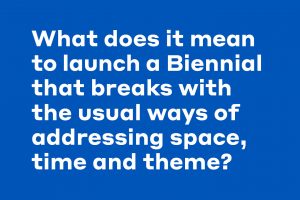What does it mean to launch a Biennial that breaks with the usual ways of addressing space, time and theme?
osloBIENNALEN FIRST EDITION 2019-2024: Prologue Symposium
May 27, 2019, 2–6:30pm
osloBIENNALEN
Myntgata 2
0151 Oslo
Norway
Curated by Eva González-Sancho Bodero and Per Gunnar Eeg-Tverbakk, osloBIENNALEN FIRST EDITION 2019-2024 proposes an evolving five-year project, working with art and artists in public space and the public sphere, based on four concepts and structures: Art Production within a Locality; Addressing the Myriad; New Institutional Ecologies; A Collection for the Passerby.
We hope these concepts will influence broader cultural policy concerning the support, thinking, display, public outreach and collecting of art in public space.
The prologue symposium will introduce the debates taking place during the symposia programme, which will unfold throughout the Biennial’s duration, focusing on the context of art in public space and the public sphere, and the relations between institution, artists, their work and audiences, both engaged and non-constituted. Download the full symposium programme here.
A work of art in public space is apparently free from institutional context and the apparatus that express the work’s significance and canonical value. Outside the gallery, it can appear as artefact, invited or uninvited guest, stranger, or ghost. How might a biennial back art practises dealing with the varying tempos and rhythms of public space? How might it develop new institutional ecologies affecting artists, existing models, and city administration, or connect with partners to work on shared concerns? Can the biennial model establish a new ethos to meet the challenges of working for the passerby? How should this be applied? How might we, for example, address immaterial art production in connection with a locality, or how immaterial works in public space enter art collections, through protocols that (re)activate them rather than just displaying documentation.
We believe that language and communication tools should engage with the conditions to which art in public space is subject. We cannot take for granted that discourse will reach a diverse set of “passersby,” or that they even wish to access the work on display. To communicate, we must understand the precise nature of the work, its context and receivers.
Following the structure of a book, manual or tutorial, the symposia programme is organized as a succession of parts. The prologue will introduce key aspects of the biennial’s founding concepts and future discussions. Then come four chapters of two-day symposia, developed in collaboration with a range of specialists to deepen and expand thinking on each concept. Afterwards, a series of footnotes, providing views from the periphery in which philosophers, sociologists, urban researchers, educators and artists selected in conversation with the biennial participants, will give talks at key locations around the city, creating a dialogue with some of the works. Lastly, an epilogue, in radio/podcast format, will reflect on what we did.
The symposia program will provide opportunities to appreciate, discuss, and possibly contribute to the biennial’s evolving production framework and apparatus, conceived to operate in public space, to foster art in the making, its display, communication and engagement with publics, and to meet the challenges of collecting for the contingencies of the public sphere. In this way, the symposia will question the role of the public institution, its values, procedures and actions, and their coherence. These should be determined by ethics and legislation regarding labour, rights, how finance is raised and used. To optimise art production, public outreach and ethos, the institution must focus on the needs of art and artists, responding to them through appropriate modus operandi. This is a matter of time and praxis.
Characteristic of the biennial itself, hospitality, mobility, belonging, displacement, rhythm, memory, imagination and time will be essential terms in the symposia programme’s development, applied to generate knowledge while navigating the four founding concepts through cross-flow subjects and narratives. Rather than a series of linear and frontal conferences, the symposia program adopts diverse discursive formats, creating varying group dynamics so that multiple perspectives may come together to configure a common ground. In this way, the symposium will set out to foster an open and horizontal conversation aimed at non-hierarchical forms of knowledge production.
Monday, May 27, 2019
From 2 to 6:30pm, followed by a dinner
The prologue symposium includes keynote talks, thereafter debated by guest discussants.
Participants include: osloBIENNIALEN curators Eva González-Sancho Bodero and Per GunnarEeg-Tverbakk, with osloBIENNIALEN Research and Symposium Associate, Juan Canela.
Keynote speakers: Dora García (artist, art teacher); Marius Grønning (architect, urbanist); Mikaela Assolent (art educator, PhD researcher in Feminism, Sexual Politics, and Visual Culture); Shwetal A. Patel (researcher and advisor – Institutional Relations osloBIENNIALEN).
Discussant guests speakers: Binna Choi (director CASCO Art Institute Utrecht); Claire Doherty (director, producer); Dmitry Vilensky (artist, educator, founding member of ChtoDelat collective, St Petersburg); Farid Rakun (ruangrupa artist collective selected to curate documenta 15); Jesús Fuenmayor (Adjunct Art Professor, University of Florida; curator XIV Cuenca Biennial Ecuador); Lara García Díaz (artist, activist, PhD researcher at ARIA, Antwerp); Marianne Heier (artist); Paul O’Neill (artistic director, PUBLICS, Helsinki); Ruben Steinum (artist, chairman of UKS – Young Artists Society, Oslo); Tereza Stejskalová and Vít Havránek (curators of Matter of Art, Biennale Prague, 2020, tranzit.cz) and Ulrikke Neergaard (director of KØS Denmark).


